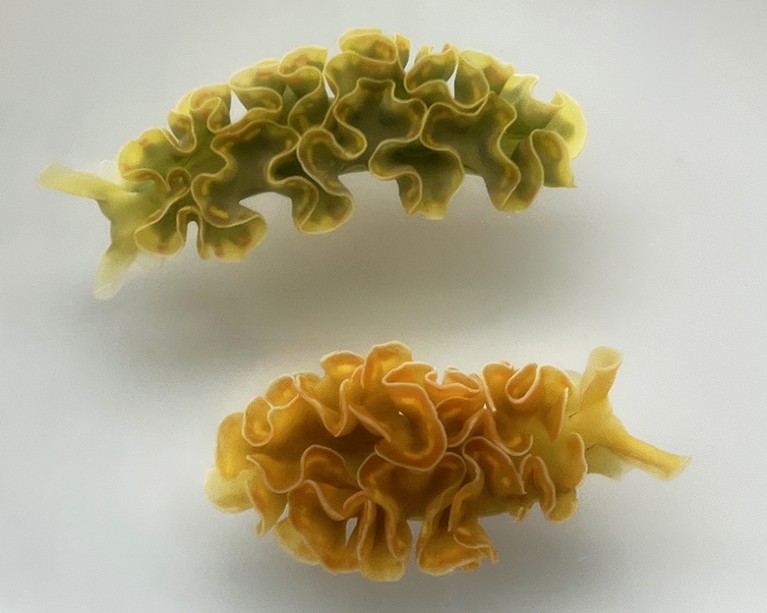You have full access to this article via your institution.
Hello Nature readers, would you like to get this Briefing in your inbox free every day? Sign up here.

Electroencephalography can be used to study brain activity while people are completing tasks with and without the help of chatbots such as ChatGPT.Credit: Leah Nash/Washington Post/Getty
The brains of people using the artificial-intelligence bot ChatGPT to write an essay are less engaged than those without access to online tools. Researchers also found that relying on a chatbot for initial tasks might lead to relatively low levels of brain engagement even when the tool is later taken away. Computer scientist and study co-author Nataliya Kosmyna advises that the results are taken with a pinch of salt. The experiment studied only a handful of people over a short time. It cannot and did not show “dumbness in the brain, no stupidity, no brain on vacation”, she says.
Reference: arXiv preprint (not peer reviewed)
An artificial-intelligence (AI) model developed by Google DeepMind could help scientists to make sense of ‘dark matter’ in the human genome — areas of genetic code that do not code for proteins. The model, called AlphaGenome, takes long stretches of DNA and predicts various properties, such as the expression levels of the genes they contain and how those levels could be affected by mutations. Such predictions could help scientists determine how ‘dark’ areas of DNA contribute to diseases such as cancer and influence the inner workings of cells.
Reference: Google DeepMind preprint (not peer reviewed)
‘Solar-powered’ sea slugs (Elysia crispata) steal photosynthetic equipment from algae and stockpile it to use as an energy source on a rainy day. The slugs store these stolen tools, called chloroplasts, in specialized depots in their cells — dubbed ‘kleptosomes’. Day-to-day, the chloroplasts let the slugs make nutrients using energy from sunlight. But when the going gets tough the energy-makers become food: the slug breaks them down and absorbs the resulting nutrients. Using this trick, researchers found that Elysia can survive for up to four months without another food source.

After four weeks of food deprivation, green Elysia sea slugs turn orange.Credit: Corey Allard
Features & opinion
Many of the electronic gadgets and systems on Earth are vulnerable to one danger: electromagnetic disruption caused by a coronal mass ejection (CME). “A solar flare is the flash of ignited powder,” says solar physicist Ryan French. “The CME is the cannonball.” Inside three institutions — in the United Kingdom, the United States and Australia — solar-storm watchers stare into the Sun to forecast when a CME might deliver a gut-punch to our networked world.
Times change, but stew is forever in the latest short story for Nature’s Futures series.
A study of computer-vision research reveals “an overwhelming amount of uses of both papers and patents is in surveillance,” says cognitive scientist Abeba Birhane, who co-authored the research. Some applications are innocuous: computer vision is used in sport to track players and assess their performance, for example. Others not so much. “From the western world to African nations, you see that these governments are utilizing these surveillance systems to crush down dissent,” says Birhane.
If you listen to the Nature Podcast, we’d be very grateful if you would take this short survey for listeners. Thank you!
Nature Podcast | 31 min listen
Subscribe to the Nature Podcast on Apple Podcasts, Spotify or YouTube Music, or use the RSS feed.
Today Leif Penguinson is getting to the root of a Myristica magnifica tree in a swamp forest in Karnataka, India. Can you find the penguin?
The answer will be in Monday’s e-mail, all thanks to Briefing photo editor and penguin wrangler Tom Houghton.
This newsletter is always evolving — tell us what you think! Please send your feedback to [email protected].
Thanks for reading,
Flora Graham, senior editor, Nature Briefing
With contributions by Jacob Smith
• Nature Briefing: Careers — insights, advice and award-winning journalism to help you optimize your working life
• Nature Briefing: Microbiology — the most abundant living entities on our planet — microorganisms — and the role they play in health, the environment and food systems
• Nature Briefing: Anthropocene — climate change, biodiversity, sustainability and geoengineering
• Nature Briefing: AI & Robotics — 100% written by humans, of course
• Nature Briefing: Cancer — a weekly newsletter written with cancer researchers in mind
• Nature Briefing: Translational Research — covers biotechnology, drug discovery and pharma


